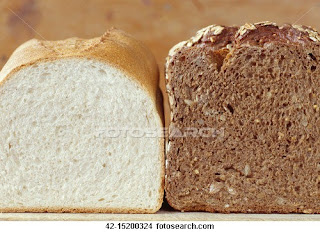Its been a week since I last blogged. But anyone who knows me will also know that very little usually comes in the way of nutrition, writing and I. And, if it ever did, it has to be really superlative. So here I am typing away furiously about the role of the word 'brown' when it comes to food. To elaborate, have you noticed that the word `brown' when prefixed to any food automatically makes the food sound healthier than its, uhhh, not-so-brown counterpart? For instance, say 'white bread' to any health conscious human and you get a conditioned disapproving look. Now say 'brown bread' and the look changes to that of approval and sometimes reverence. So is it true? Is brown better when it comes to some types of food? Lets see shall we,
Brown Bread: The term `brown bread' is meant to indicate bread made with whole wheat flour or whole grain wheat flour. Yes, brown bread is nutritionally better than white bread, but only if you get the real product (as some manufacturers add caramel to make white bread look brown).
What you can do to verify is read the ingredients listed on the bread packaging and see if the word 'caramel' is present. If you see only the word 'caramel' but no words like: whole wheat flour or whole grain wheat flour or atta (Hindi for wheat flour), then skip that brand. But, if you do see those words and listed amongst the top three ingredients by weight, then buy that brand irrespective of whether caramel is present. Remember, I am only talking about plain bread here and not multi-grain bread or bread made using a mix of different pulse/grain like soy, oat, finger millet etc.
Brown Rice: Dont confuse brown rice with parboiled rice, they are different. Brown rice is a grain of rice which has lost just one layer during milling, namely its outer husk. Whereas the rice which we commonly eat and refer to as white rice, has lost two more layers during milling, in addition to the husk. Brown rice beats white rice hands down in nutritional value (vitamin, mineral and fiber content), so go for it if the extra cost is not a bother. An option which is cheaper than brown rice but nutritionally better than white rice, is parboiled rice. Lets talk about it sometime in my future blogging sessions.
Brown (Chicken) Egg: The color of the shell in some eggs is brown/beige/cream because the breed of chicken which lays these, lays them in that color. Example of brown egg laying chicken breeds: Australorp, Brahma and quite a few more. Brown eggs are not nutritionally superior to white shelled ones, they are both nutritional equals. There is thus, no strong reason to pay more for brown shelled eggs, unless you want to spend extra for just the appealing shell color.
Brown Sugar: Not talking of the infamous drug here, but of sugar which is brown in color. How? Sugar in its early stages of refining or sugar which is semi-refined, has a residue of mollasses (a viscous by product of the sugar manufacturing process) and mollasses are what give the sugar its brown color (at this stage). This is called natural brown sugar.
Brown sugar can also be made by mixing mollasses with regular white sugar, in which case its not `natural'. Brown sugar has great value in the culinary world, but lets stick to discussing if its nutritionally better than white sugar. Natural brown sugar does have greater mineral content than white, so yes, by that count it is better than white sugar. Natural brown sugar is however hygroscopic (attracts moisture) and may be difficult to store and use. Brown sugar may also cost more. So in the end, its better nutritional value vs practicality plus cost factor. Therefore, whether or not to buy brown sugar is entirely the purchasers call.
As you can see, three out of four times, brown is better when it comes to some food types. But, its not really simple to tell people to choose an X food over a Y, as many factors affect individual food choices including family practice, customs, taste preference, cost factor, ease of use while cooking, easy availability in local shops and ease of storage. Ultimately, the desire to implement healthy eating habits always starts from within. Moving on...until my next blogging bout. Stay happy!
If you liked this post, you might also like,
The Nutrition Omnibus and A Fistful of Nutrition ©Raksha Changappa. Contents of this blog post (excluding images) are the exclusive copyright and intellectual property (IP) of Raksha Changappa. This post is solely for knowledge and information of the reader. If you want to use the post contents, kindly do so by acknowledging the source, namely this blog and the author, via hyperlinks or credits. If not, no content will be copied, reproduced, republished, transmitted or distributed, in any form or means, including print and electronic media. Copyright and IP infringements will be taken seriously. For queries contact nutrewise@yahoo.com
